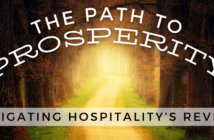This summer is proving to be hot for hoteliers’ bottom lines. Here’s what is driving business – and how you can cash in on the opportunities.
by ALICIA HOISINGTON
For the United States hotel industry, opportunities abound during summer months as hoteliers cash in on good weather and an uptick in travelers. But while last summer only offered lackluster sales, this summer’s tale is already proving to be one with a happy ending for hoteliers’ wallets.
“Last year, the story was inconsistency,” says John Hach, senior industry analyst at TravelClick. “We’d see sporadic gains and then retractions in markets. That inconsistency was playing out for well over a year.”
That doesn’t seem to be the case this year. What we’ve seen is organic growth, and it’s taken some of the pressure off (average daily rate),” he says. “As we saw last year, a lot of the revenue-per-available-room growth was really coming off rate increases and not necessarily growth in transient or the business segment.”
But looking forward at data on the books through all of 2018, Hach says the industry is seeing good balance with organic growth across the major segments of transient, business and group.
“It’s looking to be a promising year,” he says, adding that ADR continues to hold. “I don’t think hoteliers are going to be less dependent on trying to drive RevPAR through ADR. Because we’ve seen such slowing ADR growth in many markets over the recent years, I think it does turn out to be one of those better outlooks than we’ve had, especially going into the spring and summer months.”
The outlook appears steady from STR’s point of view, too. The hotel data benchmarking company expects the U.S. hotel industry to continue the trend it started in 2010 with continued demand growth outpacing supply growth that will lead to further occupancy gains, according to Jan Freitag, senior vice president of lodging insights at STR.
“The U.S. GDP is expected to grow at a healthy clip, fueled by tax cuts and continued low unemployment, which increases leisure spending,” he says. “Hoteliers, in general, and resorts should be the beneficiaries during the summer of 2018.”
However, despite occupancy reaching all-time records, Freitag says that STR does not expect room rates to increase sharply.
“Rate growth, or lack thereof, has been the conundrum vexing the hotel industry in the past, and we do not expect that trend to change this year,” he says. “That said, slight occupancy increases, coupled with moderate room rate growth, bodes well for healthy RevPAR growth in the summer of 2018.”
The segments driving summer business
Freitag says that STR expects U.S. room supply to increase at just below 2 percent, driven primarily by an increase in the limited-service segment, especially from upscale and upper-midscale brands.
“We have continually been positively surprised by the very healthy increase in room demand growth for those two sectors. We do not see that trend changing in 2018,” he says. “The limited-service sector will continue to show very healthy demand growth numbers. But just like for the nation, pricing power will remain elusive.”
Hach says a positive outlook for transient business is holding strong through this summer and into fall.
“If you look at committed occupancy through the fourth quarter of 2018, we’re seeing that we’re actually up 2.3 percent compared to a year ago. Last year, we were basically flat at 0.5 percent (transient) growth for 2017,” he says. “That transient uptick is giving me a much more positive viewpoint for how 2018 is going to play out.”
Group business, which is up 1.9 percent, is holding steady, Hach adds.
“A 1.9 percent in group gives us a solid base. I like that,” he says. “Some of that business demand is actually being recalibrated now within transient because of the uptick in loyalty programs. You’re seeing more member rates, which tend to be a little bit more transient.
“I’m not overly concerned about business demand because I do see there’s some move-over into member rates, especially with the push that the major brands have on those types of offerings for the loyalty customers,” Hach says.
Driving summer business
For Scott Koster, regional vice president for Two Roads Hospitality and general manager of Gild Hall in New York City, and his team, summer strategy starts with an early focus on group business.
“We find that some groups traveling to key markets such as New York City for retreats or conferences are looking to book during off-season times as a way to cut back on overall costs,” Koster says.
In May, the team also will be launching its 2018 summer campaign, which Koster says helps to drive bookings and revenue across Two Roads Hospitality’s portfolio, which includes its Thompson Hotels, Joie de Vivre Hotels and Destination Hotels brands. The campaign will offer several promotions for those brands. Koster says that last year the company ran a similar summer program and it boosted business in big ways.
“These brand promotions offer a variety of incentives around summer travel, and last year the overall campaign resulted in more than $8 million in direct revenue, over $4 million in attributed revenue and more than 33,000 room nights booked,” Koster says.
To drive summer business, TravelClick’s Hach says hoteliers need to really think about the local competition and what differentiates their properties from the pack.
“It’s thinking about what I’m offering at this day and time,” he says. “What makes this hotel stand out? If everyone is charging the same rate, what’s the tie breaker? The tie breaker is more than loyalty these days. It’s local value-add.”
That concept proves true for 21c Museum Hotels, as CEO Craig Greenberg says community engagement and local partnerships are critical to driving summer business at his hotels.
“Our properties host cultural programs that we coordinate and are also focused on building partnerships with neighboring institutions,” he says. For example, the 21c Bentonville in Arkansas saw increased occupancy and rate due to a partnership with the Crystal Bridges Museum of American Art promoting its Dale Chihuly exhibition last summer.
Art is at the heart of the 21c brand and experience, Greenberg says, and the summer months offer a great opportunity to feature rotating exhibitions. These exhibits are open to the public and are free of charge, but they help to get people through the door.
“Each of our exhibitions is a reflection of current issues and happenings in the world, allowing visitors to experience global culture while also connecting with local communities,” Greenberg says.
He says that each property in the portfolio has the opportunity for unique local experiences. The 21c Bentonville, for instance, draws from the local Ozarks as a prime destination for bikers and offers a bike washing station, trail maps and other amenities to help bikers navigate the area throughout the hotel’s busy summer months.
Koster says that local experiences are equally important to drive business at his properties during the summer months, too.
“Summer tends to be a period of trial for guests looking to explore new places. We have learned that although there are a lot of new hotels in the market, no one is really providing the level of service and authenticity that our guests crave,” he says.
That’s why Thompson Hotels recently launched its “Uncovered by Thompson Hotels” program that brings exclusive “uncovered” moments to guests that “enhance guests’ stays with insider happenings and immersive, local experiences they can’t find anywhere else,” Koster says.
For example, at Hotel 50 Bowery, a Joie de Vivre property in Manhattan’s Chinatown, guests can enjoy drinks and small bites while looking out over the city at The Crown, the hotel’s rooftop bar and lounge.
“Obviously, people tend to gravitate toward outdoor experiences during the summer months, and with New York City offering a range of rooftop moments with distinct personalities, The Crown is a huge draw for those visiting the Chinatown neighborhood during this time,” Koster says.
He says that rooftop concepts are significant drivers of summer business, especially if hoteliers focus on diverse programming to activate the spaces – whether that’s through live music, outdoor wellness experiences or cocktail hours. For instance, the company recently opened Joie de Vivre’s Hotel Revival in Baltimore this spring, which boasts a rooftop restaurant and bar called Topside. The seafood-centric, elevated beer hall emphasizes unique local beers with 13 taps and more than 60 bottles and cans, highlighting the strength of the Maryland craft beer movement.
“Local offerings such as these – and incredible views – bring guests through our doors and keep them coming back throughout the year,” Koster says. ■
What’s boosting summer business?
“In 2018, more people will travel globally than ever before. In this global marketplace, what guests are paying in their own currency can often drive purchase behavior. A somewhat weaker U.S. dollar bodes well for the attractiveness of U.S. hotels as hotel rooms are cheaper than they were a year ago in Euros, British Pounds and Chinese Renminbi.”
–Jan Freitag, senior vice president of lodging insights at STR
How can hoteliers boost their summer business?
“A local competitive differentiation can help you differentiate from your competitive set and hotels that are three to five miles away charging plus or minus $25 from your rate. Sometimes hotels can get caught up in the star rating and not the geographical part or price range. A differentiation from the competitive set and Airbnb can get you that early boost from transient. You don’t want to be a commoditized hotel just offering the same rate.”
–John Hach, senior industry analyst
at TravelClick
2018 forecasts show industry optimism
2018 is forecast to be a good year for the United States hotel industry, according to several research firms. From record-breaking occupancy levels to bursting investor confidence, here’s what some of the top prognosticators think this year has in store for the industry.
STR and Tourism Economics
The U.S. hotel industry is projected to post record-breaking performance levels through 2019, according to STR and Tourism Economics’ initial joint forecast for 2018. Some key findings include:
- Supply will increase 2 percent in 2018 and 1.9 percent in 2019.
- Demand will grow 2.3 percent in 2018 and 2 percent in 2019.
- Occupancy will see slight growth of 0.3 percent in 2018 and 0.1 percent in 2019.
- Average daily rate will grow 2.4 percent this year and 2.3 percent next year.
- RevPAR will see a 2.7-percent gain in 2018, and it will grow 2.4 percent in 2019. In 2018, the luxury and independent chain-scale segments are likely to report the largest increases in occupancy (+0.4 percent).
- Independent hotels are projected to post the most substantial growth in ADR (+2.5 percent) and RevPAR (+2.9 percent) in 2018.
- The upscale segment is projected to grow the least in RevPAR this year at 1.8 percent.
JLL
JLL’s “North America Hotel Investor Sentiment Survey” collected more than 5,000 data points from hotel investors to measure their expectations for 2018. They found that investors are more confident about the hotel sector now than they were in late 2016. Some other key findings include:
- Investor confidence is attributed to strong RevPAR trends, a robust macro economy, a rising stock market and corporate confidence due to tax reform and other initiatives from the government.
- Hotels provide favorable strong risk-adjusted returns and a hedge against inflation.
- Los Angeles, Washington D.C., San Francisco, Boston, Vancouver and Hawaii are the markets that received the most positive performance expectations.
PwC
RevPAR has been growing for eight straight years. With that, PwC’s forecast for 2018 sees that a stable economy and tax stimulus will help to support the highest occupancy level in the hospitality industry since 1981. Some other key findings of PwC’s “Hospitality Directions US” include:
- The leisure transient segment will continue to drive room-night demand.
- Inbound international travel declined in the first and second quarters of 2017, but the weakening U.S. dollar could help to offset that loss moving forward.
- Corporate transient travelers will continue to show slow demand growth, which has helped contribute to the slow ADR growth.
- Underlying macroeconomic and industry fundamentals are expected to stay strong.
- Supply growth is expected to reach the long-term average and increase to 2 percent.
- Demand growth is expected to continue to support the record occupancy levels.




